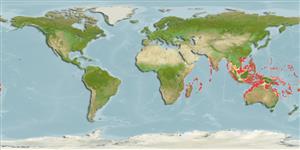Environment: milieu / climate zone / depth range / distribution range
Οικολογία
Θαλασσινό(ά) Υφαλόφιλο(α); εύρος βάθους 50 - 300 m (Ref. 4319). Tropical; 21°N - 32°S, 30°E - 179°W (Ref. 5222)
Indo-West Pacific: Natal coast of South Africa, northern Mozambique, Reunion, Mauritius, New Caledonia, Philippines, New Guinea, New Ireland, and Fiji. Recently recorded from Tonga (Ref. 53797). Unknown in the Red Sea and Persian Gulf.
Μέγεθος / Βάρος / Age
Maturity: Lm ? range ? - ? cm
Max length : 150 cm TL αρσενικό/απροσδιόριστο; (Ref. 4787); μεγ. δημοσιευμένο βάρος: 50.0 kg (Ref. 4787)
Ραχιαίες άκανθες (συνολικά) : 11; Μαλακές ραχιαίες ακτίνες (συνολικά) : 14 - 15; Εδρικές άκανθες: 3; Μαλακές εδρικές ακτίνες: 8. Distinguished by the following characteristics: pale brown body color with small dark brown to greyish green spots unevenly scattered on the dorsolateral parts of the head and body, dorsal and caudal fin; one row of close-set spots running posteriorly from the eye in a distinct line; absence of spots on the body below the level of the pectoral fins or on the anal and paired fins; body depth contained 2.7-3.2 times in SL; head length 2.2-2.4 times in SL; flat to convex interorbital area, dorsal head profile almost straight; angular preopercle, 2-4 distinctly enlarged serrae at angle; slightly convex upper edge of operculum; posterior nostril not much larger than anterior nostril; maxilla reaches below rear half of eye, ventral edge with low step at the distal expansion; 2 rows of teeth on midlateral part of lower jaw, inner teeth larger than outer teeth (Ref. 89707).
Known only in deep water in the vicinity of coral reefs. Biology unknown. It is an excellent food fish.
Life cycle and mating behavior
Maturities | Αναπαραγωγή | Spawnings | Egg(s) | Fecundities | Προνύμφες
Heemstra, P.C. and J.E. Randall, 1993. FAO Species Catalogue. Vol. 16. Groupers of the world (family Serranidae, subfamily Epinephelinae). An annotated and illustrated catalogue of the grouper, rockcod, hind, coral grouper and lyretail species known to date. Rome: FAO. FAO Fish. Synop. 125(16):382 p. (Ref. 5222)
IUCN Red List Status (Ref. 130435)
Threat to humans
Harmless
Human uses
αλιεία: Εμπορικό(ά)
Εργαλεία
Special reports
Download XML
Διαδικτυακές πηγές
Estimates based on models
Preferred temperature (Ref.
123201): 17.9 - 27.6, mean 23.7 °C (based on 194 cells).
Phylogenetic diversity index (Ref.
82804): PD
50 = 0.5000 [Uniqueness, from 0.5 = low to 2.0 = high].
Bayesian length-weight: a=0.01820 (0.01098 - 0.03017), b=3.10 (2.96 - 3.24), in cm total length, based on LWR estimates for this species & Genus-body shape (Ref.
93245).
Τροφικό Επίπεδο (Ref.
69278): 4.1 ±0.6 se; based on size and trophs of closest relatives
Ελαστικότητα (Ref.
120179): Χαμηλό, ελάχιστος χρόνος για διπλασιασμό πληθυσμού 4,5 - 14 έτη (tmax=11; Fec=46,769).
Fishing Vulnerability (Ref.
59153): Very high vulnerability (90 of 100).
Nutrients (Ref.
124155): Calcium = 15.1 [7.1, 33.8] mg/100g; Iron = 0.431 [0.219, 0.880] mg/100g; Protein = 18.8 [17.3, 20.2] %; Omega3 = 0.125 [0.072, 0.215] g/100g; Selenium = 66.9 [36.0, 135.9] μg/100g; VitaminA = 76.6 [20.8, 280.9] μg/100g; Zinc = 0.862 [0.587, 1.270] mg/100g (wet weight);
